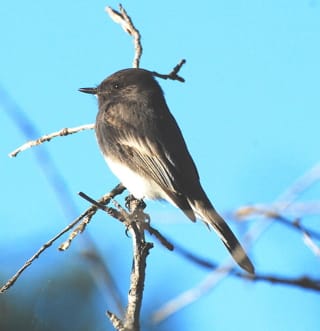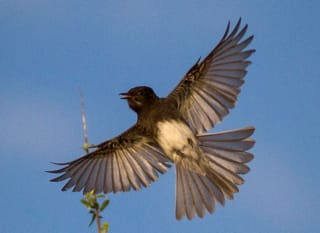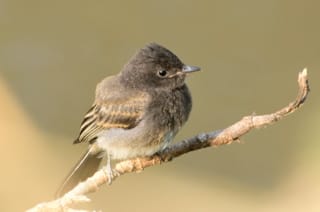Initially this guide displays common birds of all types that are flying right now in our area. Use the selectors below to view rare birds, view birds flying any time, restrict the output to a certain shape of bird, or search by name.
New Mexico is on the western edge of the Central Flyway which is one of the major migration pathways between north and south for birds traveling between breeding and wintering grounds along the Rocky Mountains. This has resulted in the state having an incredible diversity of birds with over 550 different species reported. A little more than half of this number are sighted annually on the Pajarito Plateau. Some of these birds are full-time residents, some migrate here for a few weeks or months, and other are only seen briefly as they pass through the region.
This guide features many of the birds known to frequent Los Alamos county by when they are likely to be seen in the area. You can get additional information on local birds by joining PEEC Birders or going to the eBird website. eBird also includes lists of rare bird sightings and birding hot spots.
Bird References
Birdweb
Cornell Lab of Ornithology
eBird
eNature
Institute for Bird Populations
National Audubon Society
New Mexico Ornithology Society
What Bird
xeno-canto
Subject Area Experts (all guides)
Steve Cary (butterflies)
Beth Cortright (insects)
Terry Foxx (invasive plants)
Leslie Hansen (mammals)
Richard Hansen (fish, mammals)
Dorothy Hoard (butterflies, trees)
Chick Keller (flowers, herbarium)
Shari Kelley (geology)
Kirt Kempter (geology)
Garth Tietjen (reptiles)
David Yeamans (birds)
Web Development and Content Management
Pat Bacha
Jennifer Macke
Graham Mark
Akkana Peck
Contact
Please contact us for local nature questions and sightings. We welcome comments, corrections, and additions to our guides.
For more information about local nature, please visit our Nature Blog or subscribe to PEEC This Week.
Make Selection
 Photo: adult by Jerry Oldenettel  Photo: adult by Mouser Williams  Photo: immature by Ricardo A. T. |  Black Phoebe, Black FlycatcherBLPH (Sayornis nigricans)Family: Tyrannidae (Tyrant Flycatchers) Size: 6 - 7 in (15 - 18 cm) Flies: Feb 15 - Sep 21 Morphology: adults are mostly dark gray on the upperparts with a gray chest, white belly, and black head that may show a slight peak on the crown; immatures are similar but with buffy-colored wingbars Status: native; locally common Food source: wide variety of insects including beetles, grasshoppers, crickets, bees, wasps, and caterpillars; occasionally will eat small fish Habitat: shady areas in open woods near water Typical location: Rio Grande Black Phoebes can often be seen on a perch low over water, wagging their tails up and down. Once an insect is sighted, the bird will dart out to catch its prey mid-air or even to pluck it off the water surface. Phoebes will also hover while picking insects from foliage. They are territorial and often maintain an established territory year-round. A male will perform a song-flight display during courting and show the female a potential nesting site. The female will then build a nest made of mud, plastered to a protected spot such a cliff face, bridge support, or building wall. Young usually leave the nest at 2 to 3 weeks of age. There are typically 2 broods per year. Info Photos Distribution Frequency |
